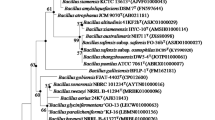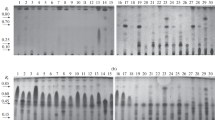Abstract
Suspension cell culture of camel’s thorn Alhagi persarum Boiss. et Buhse was produced for the first time and its characteristics were determined under different growing conditions (flasks and bubble bioreactors with useful volume of 15 L). The obtained culture was notable for an intense growth (accumulation of dry biomass of 15–20 g/L, growth index of 11–16, and specific growth rate of 0.15 ± 0.01 d–1), with growth characteristics in bioreactors close to parameters observed in flasks. Qualitative composition of secondary metabolites in biomass of this cell culture grown in flasks was preliminarily examined by means of ultra-performance liquid chromatography coupled with mass spectrometry (UPLC-ESI-MS). Isoflavones from different structural groups were detected: free isoflavones (an isomer of afrormosin), glycosides of isoflavones (glycosides of calycosin and formononetin), and acylated glycosides of isoflavones (malonyl glycosides of calycosin, formononetin, genistein, and the isomer of afrormosin). Extracts from biomass of A. рersarum suspension cell culture grown in flasks were tested for antimicrobial activity. Staphylococcus aureus АТСС 25923 and Pseudomonas aeruginosa АТСС 27853 were used as test cultures. Extracts showed a specific antimicrobial activity in respect to S. aureus but were inactive to P. aeruginosa. Thus, the obtained cell culture of A. persarum is a promising object for further examination with a potential of using as an alternative raw material and a source of biologically active compounds characteristic of this species.



Similar content being viewed by others
REFERENCES
Alqasoumi, S.I., Al-Rehaily, A.J., Al Sheikh, A.M., and AbdelKader, M.S., Evaluation of the hepatoprotective effect of Ephedra foliate, Alhagi maurorum, Capsella bursa-pastoris, and Hibiscus sabdariffa against experimentally induced liver injury in rats, Nat. Prod. Sci., 2008, vol. 14, p. 95.
Naseri, M.K.G. and Mard, S.A., Gastroprotective effect of Alhagi maurorum on experimental gastric ulcer in rats, Pak. J. Med. Sci., 2007, vol. 23, p. 570.
Shaker, E., Mahmoud, H., and Mnaa, S., Anti-inflammatory and anti-ulcer activity of the extract from Alhagi maurorum (camelthorn), Food Chem. Toxicol., 2010, vol. 48, p. 2785.
Neamah, N.F., A pharmacological evaluation of aqueous extract of Alhagi maurorum, Global J. Pharmacol., 2012, vol. 6, p. 41.
Marashdah, M.S. and Al-Hazimi, H.M., Pharmacological activity of ethanolic extract of Alhagi maurorum roots, Arab. J. Chem., 2010, vol. 3, p. 39.
Marashdah, M.S. and Farraj, A.I., Pharmacological activity of 2% aqueous acetic acid extract of Alhagi maurorum roots, J. Saudi Chem. Soc., 2010, vol. 14, p. 247.
Abu-Taleb, A.M., El-Deeb, K., and Al-Otibi, F.O., Bioactivity of some plant extracts against Drechslera biseptata and Fusarium solani, J. Food Agric. Environ., 2011, vol. 9, p. 769.
Rahman, S.M.A., Abd-Ellatif, S.A., Deraz, S.F., and Khalil, A.A., Antibacterial activity of some wild medicinal plants collected from western Mediterranean coast, Egypt: natural alternatives for infectious disease treatment, Afr. J. Biotechnol., 2011, vol. 10, p. 10733.
Towhidi, A. and Zhandi, M., Chemical composition, in vitro digestibility and palatability of nine plant species for dromedary camels in the province of Semnan, Iran. Egypt. J. Biol., 2007, vol. 9, p. 47.
Piri, A., Palangi, A., and Eivazi, P., The determination of nutritive value of Alhagi by in situ and gas production techniques, Eur. J. Exp. Biol., 2012, vol. 2, p. 846.
Muhammad, G., Hussain, M.A., Anwar, F., Ashraf, M., and Gilani, A.H., Alhagi: a plant genus rich in bioactives for pharmaceuticals, Phytother. Res., 2015, vol. 29, p. 1.
Nosov, A.M., Functions of plant secondary metabolites in vivo and in vitro, Fiziol. Rast., 1994, vol. 41, p. 873.
Bharal, S. and Rashid, A., Tissue culture of Alhagi camelorum—a legume of high regenerative capacity, Physiol. Plant, 1981, vol. 3, p. 497.
Hassanein, A.M. and Mazen, A.M.A., Adventitious bud formation in Alhagi graecorum, Plant Cell, Tissue Organ Cult., 2001, vol. 65, p. 31.
Dhaniya, S. and Parihar, S.K., In-vitro callus induction and multiplication of inter-nodal explants in plants Dicoma tomentosa and Alhagi maurorum, J. Drug Delivery Ther., 2019, vol. 9, p. 212.
Titova, M.V., Kochkin, D.V., Sobol’kova, G.I., Fomenkov, A.A., Sidorov, R.A., and Nosov, A.M., Cultivation and characteristics of cell callus culture of Alhagi persarum Boiss. et Buhse—isoflavonoid producers, Biotekhnologiya, 2020, vol. 36, p. 35.
Gamborg, O.L., Miller, R.A., and Ojima, K., Nutrient requirements of suspension cultures of soybean root cells, Exp. Cell Res., 1968, vol. 50, p. 51.
Nosov, A.M., Popova, E.V., and Kochkin, D.V., Isoprenoid production via plant cell cultures: biosynthesis, accumulation and scaling-up to bioreactors, in Production of Biomass and Bioactive Compounds Using Bioreactor Technology, Paek, K.-Y. Murthy, H.N., and Zhong, J.-J., Eds., Dordrecht: Springer-Verlag, 2014, p. 563.
Titova, M.V., Shumilo, N.A., Kulichenko, I.E., Ivanov, I.M., Sukhanova, E.S., and Nosov, A.M., Features of respiration and formation of steroidal glycosides in Dioscorea deltoidea cell suspension culture grown in flasks and bioreactors, Russ. J. Plant Physiol., 2015, vol. 62, p. 557.
Nosov, A.M., Methods for estimation of growth characteristics in cell cultures of higher plants, in Molekulyarno-geneticheskie i biokhimicheskie metody v sovremennoi biologii rastenii (Molecular, Genetic, and Biochemical Methods in Current Plant Biology), Kuznetsov, Vl.V, Kusnetsov, V.V, and Romanov, G.A, Eds., Moscow: Binom, 2011, p. 386.
Abrankó, L., García-Reyes, J.F., and Molina-Díaz, A., In-source fragmentation and accurate mass analysis of multiclass flavonoid conjugates by electrospray ionization time-of-flight mass spectrometry, J. Mass Spectrom., 2011, vol. 46, p. 478.
Zhang, J., Xu, X.J., Xu, W., Huang, J., Zhu, D.Y., and Qiu, X.H., Rapid characterization and identification of flavonoids in Radix astragali by ultra-high-pressure liquid chromatography coupled with linear ion trap-orbitrap mass spectrometry, J. Chromatogr. Sci., 2015, vol. 53, p. 945.
Lee, Y.H., Kim, B., Hwang, S.-R., Kim, K., and Lee, J.H., Rapid characterization of metabolites in soybean using ultra high performance liquid chromatography coupled with electrospray ionization quadrupole time-of-flight mass spectrometry (UPLC-ESI-Q-TOF-MS/MS) and screening for α-glucosidase inhibitory and antioxidant properties through different solvent systems, J. Food Drug Anal., 2018, vol. 26, p. 277.
Zheng, Y., Duan, W., Sun, J., Zhao, C., Cheng, Q., Li, C., and Peng, G., Structural identification and conversion analysis of malonyl isoflavonoid glycosides in Astragali radix by HPLC coupled with ESI-Q TOF/MS, Molecules., 2019, vol. 24, p. 929.
Wink, M., Evolution of secondary metabolites in legumes (Fabaceae), S. Afr. J. Bot., 2013, vol. 89, p. 164.
Tong, S.Y.C., Davis, J.S., Eichenberger, E., Holland, T.L., and Fowler, V.G., Staphylococcus aureus infections: epidemiology, pathophysiology, clinical manifestations, and management, J. Clin. Microbiol. Rev., 2015, vol. 28, p. 603.
Hellen, G., Therapeutic guidelines for Pseudomonas aeruginosa infections, Int. J. Antimicrob. Agents, 2000, vol. 16, p. 103.
Ulloa-Urizar, G., Aguilar-Luis, M.A., De Lama-Odría, M.C., Camarena-Lizarzaburu, J., and del Valle Mendoza, J., Antibacterial activity of five Peruvian medicinal plants against Pseudomonas aeruginosa, Asian Pac. J. Trop. Biomed., 2015, vol. 5, p. 928.
Sama Fonkeng, L., Mouokeu, R.S., Tume, C., Njateng, G.S., Kamcthueng, M.O., Ndonkou, N.J., and Kuiate, J.R., Anti-Staphylococcus aureus activity of methanol extracts of 12 plants used in Cameroonian folk medicine, BMC Res. Notes, 2015, vol. 24, p. 710.
Alam, K., Al Farraj, D.A., Mah-e-Fatima, S., Yameen, M.A., Elshikh, M.S., Alkufeidy, R.M., Mustafa, A.E.Z.M.A., Bhasme, P., Alshammari, M.K., Alkubaisi, N.A., Abbasi, A.M., and Naqvi, T.A., Anti-biofilm activity of plant derived extracts against infectious pathogen-Pseudomonas aeruginosa PAO1, J. Infect. Publ. Health, 2020, vol. 13, p. 1734.
Funding
Producing the cell culture, growing in flasks, analysis of secondary compounds, and antimicrobial activity were supported by the Russian Foundation for Basic Research (contract no. 18-54-06021 (Az_a)). Growing of the cell culture in bioreactors was supported by the Government of the Russian Federation (MegaGrant no. 075-15-2019-1882). All the investigations were carried out using equipment of the Experimental Biotechnological Complex and the All-Russia Collection of Higher Plants’ Cell Cultures Unique Research Units on the basis of Timiryazev Institute of Plant Physiology, Russian Academy of Sciences.
Author information
Authors and Affiliations
Corresponding author
Ethics declarations
Conflict of interests. The authors declare that they have no conflicts of interest.
Statement on the welfare of humans or animals. This article does not contain any studies involving animals performed by any of the authors.
Additional information
Translated by N. Balakshina
Rights and permissions
About this article
Cite this article
Titova, M.V., Kochkin, D.V., Fomenkov, A.A. et al. Obtaining and Characterization of Suspension Cell Culture of Alhagi persarum Boiss. et Buhse: a Producer of Isoflavonoids. Russ J Plant Physiol 68, 652–660 (2021). https://doi.org/10.1134/S1021443721040208
Received:
Revised:
Accepted:
Published:
Issue Date:
DOI: https://doi.org/10.1134/S1021443721040208




